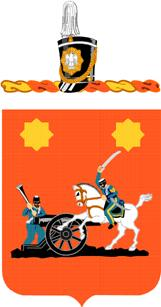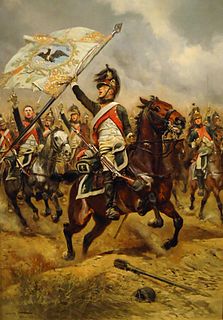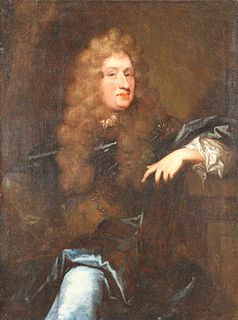
The 2nd Cavalry Regiment, also known as the 2nd Dragoons, is an active Stryker infantry and cavalry regiment of the United States Army. The Second Cavalry Regiment is a unit of the United States Army Europe, with its garrison at the Rose Barracks in Vilseck, Germany. It can trace its lineage back to the early part of the 19th century.

The Jutland Dragoon Regiment is the only regiment of the Royal Danish Army that has an armored (MBT) battalion, and is one of the Danish combat regiment in which soldiers are entitled to wear the black beret of the Armoured corps.

The Battle of Sehested was fought between Danish and Russian-Prussian-British troops at Sehested on 10 December 1813 during the War of the Sixth Coalition.

Dancon/Irak was a Danish ground contingent deployed to Iraq from June 2003 to July 2007.

The United States Cavalry, or U.S. Cavalry, was the designation of the mounted force of the United States Army from the late 18th to the early 20th century. The Cavalry branch became the Armor branch with tanks in 1950, but the term "Cavalry" such as "armored cavalry" remains in use in the U.S. Army for mounted reconnaissance, surveillance, and target acquisition (RSTA) units based on their parent Combat Arms Regimental System (CARS) regiment. Cavalry is also used in the name of the 1st Cavalry Division for heraldic/lineage/historical purposes. Some combined arms battalions are designated as armor formations, while others are designated as infantry organizations. These "branch" designations are again, heraldic/lineage/historical titles derived from the CARS regiments to which the battalions are assigned.

The Westminster Dragoons (WDs) is central London’s only Army Reserve cavalry subunit. One of the Royal Yeomanry's six squadrons, the squadron's current role is light cavalry: to provide a rapidly deployable force with fast mobility and substantial firepower in support of operations. Formed in the aftermath of Second Boer War as part of the County of London Yeomanry, the WDs fought in the Battle of Gallipoli and led British forces onto the beaches during the Normandy Invasion in 1944. The squadron most recently saw action on Operation Telic, when it was mobilised for the 2003 war in Iraq and again in 2006 for peace support operations there. Soldiers and officers of the squadron have also deployed as individual replacements on Operation Herrick in Afghanistan.

The British Columbia Dragoons (BCD) is a Primary Reserve armoured reconnaissance regiment of the Canadian Forces. It is based in Kelowna and Vernon, British Columbia. The British Columbia Dragoons are part of 3rd Canadian Division's 39 Canadian Brigade Group.
The Danish Division, short DDIV, is the only remaining military land division in Denmark. It is also the most potent single formation of the Danish armed forces. It was created on 1 January 1997 as the successor of Jutland Division. It is one of the now-two Divisions of Multinational Corps North East, the German-Danish-Polish Corps, the successor to the former German-Danish Allied Land Forces Schleswig-Holstein and Jutland (LANDJUT), a NATO Allied Forces Northern Europe formation.
The 2nd Continental Light Dragoons, also known as Sheldon's Horse after Colonel Elisha Sheldon, was commissioned by the Continental Congress on December 12, 1776, and was first mustered at Wethersfield, Connecticut, in March 1777 for service with the Continental Army. The regiment consisted of four troops from Connecticut, one troop each largely from Massachusetts and New Jersey, and two companies of light infantry.

The Royal Dragoons was a mounted infantry and later a heavy cavalry regiment of the British Army. The regiment was formed in 1661 as the Tangier Horse. It served for three centuries and was in action during the First and the Second World Wars. It was amalgamated with the Royal Horse Guards to form The Blues and Royals in 1969.

The 2nd Dragoon Guards was a cavalry regiment of the British Army. It was first raised in 1685 by the Earl of Peterborough as the Earl of Peterborough's Regiment of Horse by merging four existing troops of horse.

Armoured reconnaissance is the combination of terrestrial reconnaissance with armoured warfare by soldiers using tanks and wheeled or tracked armoured reconnaissance vehicles. While the mission of reconnaissance is to gather intelligence about the enemy with the use of reconnaissance vehicles, armoured reconnaissance adds the ability to fight for information, and to have an effect on and to shape the enemy through the performance of traditional armoured tasks.
Sir John Talbot of Lacock Abbey, Wiltshire, Long Acre, Westminster, and Salwarpe, Worcestershire, was an English soldier, politician, and landowner, who sat in the House of Commons variously between 1660 and 1687. He was a second in a duel between George Villiers, 2nd Duke of Buckingham and Francis Talbot, 11th Earl of Shrewsbury.
Ingvald Mareno Smith-Kielland was a Norwegian military officer.
The 2nd Dragoons or 2nd Dragoon Regiment may refer to:

The Army Command is the Royal Danish Army's top authority, and directly under the Defence Command. Originally created as the Army Staff, as part of the Danish Defence Agreement 2013–17, which called for major restructuring within the Danish military. It is the successor to Army Operational Command. On 1 January 2019, as part of the Danish Defence Agreement 2018–23, the name was changed to Army Command.
The Caucasus Cavalry Division was a cavalry formation of the Russian Imperial Army.















